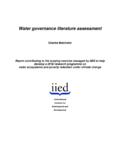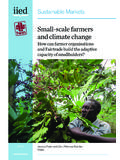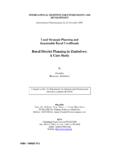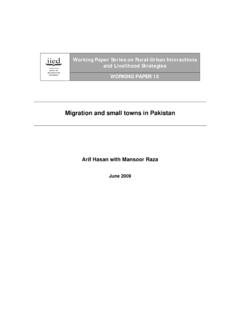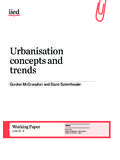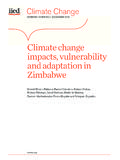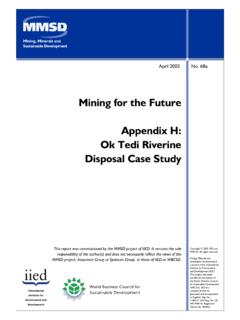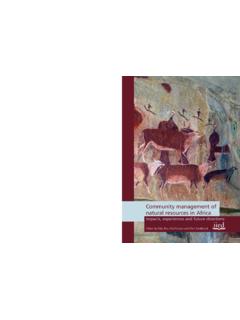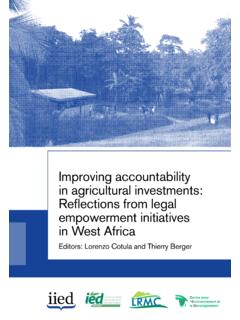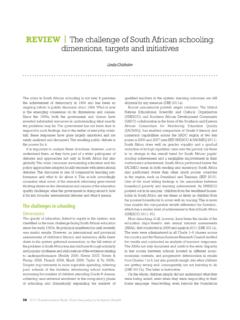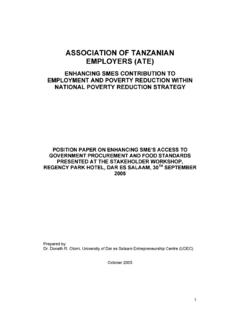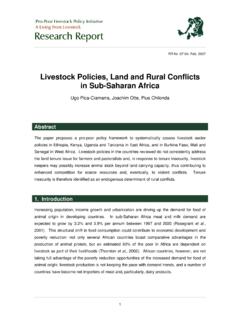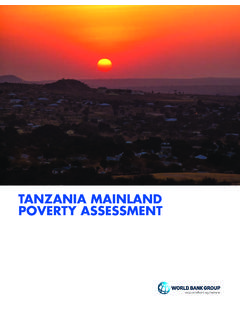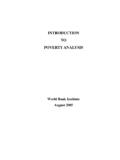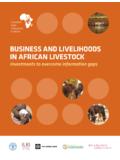Transcription of Editorial The links between urban and rural …
1 Editorial The links between urban and rural development Cecilia Tacoli I. INTRODUCTION tion. There are also significant synergies between many rural and urban interests. THIS IS THE second issue of Environment Some factors can be generalized as having a key &Urbanization focusing on rural urban linkages. role in the increase in the scale of rural urban link- The first, which came out in 1998, described the ages. Decreasing incomes from farming, especially reliance of many low-income households on both for small-scale producers who, because of a lack rural -based and urban -based resources in of land, water or capital, are unable to intensify constructing their livelihoods.
2 But the majority of and switch to higher value crops, means that the papers also underlined the fact that this strad- increasing numbers of rural residents engage in dling of the rural urban divide is usually ignored non-farm activities that are often located in urban by policy makers, and that the rigid division centres. For those who continue farming, direct between rural and urban on the part of access to markets is essential in the wake of the sectoral strategies actually makes life more diffi- demise of parastatal marketing boards and cult for low-income groups.
3 Markets are also usually located in urban centres. The papers in this issue show many reasons Better access to markets can increase farming why it has become even less realistic for develop- incomes and encourage shifts to higher value ment specialists to separate into rural and urban crops or livestock. Population growth and distri- camps. The notion of a divide has become a bution patterns affect the availability of good agri- misleading metaphor, one that oversimplifies and cultural land and can contribute to rural residents even distorts the realities.
4 As these papers demon- moving out of farming. With the expansion of strate, the linkages and interactions have become urban centres, land uses change from agricultural an ever more intensive and important component to residential and industrial, and in the peri- urban of livelihoods and production systems in many interface these processes go hand in hand with areas forming not so much a bridge over a divide transformations in the livelihoods of different as a complex web of connections in a landscape groups with the poorest often losing out.
5 Where much is neither urban nor rural , but Perhaps more significant than the absolute has features of both, especially in the areas around availability of natural resources in relation to urban centres or along the roads out of such population numbers and density are the mecha- centres (what can be termed the peri- urban inter- nisms which regulate access to, and management face). In addition, much of the rural population of, such resources. These include land tenure depends on urban centres for access to secondary systems and the role of local government in nego- schools, post and telephones, credit, agricultural tiating the priorities of different users and in extension services, farm equipment, hospitals and providing a regulatory framework which safe- government services.
6 Of course, there are still guards the needs of the most vulnerable groups conflicts between rural and urban interests. But while, at the same time, making provision for the there are also conflicts between many urban inter- requirements of economic and population growth. ests and the needs of most of the urban popula- Such mechanisms continue to call for attention, to This issue was developed in partnership with the development Planning Unit (DPU), University College London. Many of the papers in this issue were presented at the DPU Conference on rural - urban Encounters: Managing the Environment of the Peri- urban Interface held in London in Novem- ber 2001.
7 Particular thanks are due to Julio D vila, Michael Mattingly and Patrick McAlpine for helping develop this issue. The development Planning Unit also manages a research programme on the peri- urban interface; for more details see Environment&Urbanization Vol 15 No 1 April 2003 3. Editorial make it possible for more vulnerable groups to based producers to urban markets, both for local successfully plot a course through this increas- consumers and for forwarding to regional, ingly complex landscape . national and international markets; and, in the But there has also been progress in recognizing opposite direction, flows of manufactured and and responding to this complexity.
8 Many of the imported goods from urban centres to rural papers in this issue draw attention to the growing settlements. They also include flows of people intensification of the links in the rural urban moving between rural and urban settlements, continuum, describing initiatives which respond to either commuting on a regular basis, for occa- these links and the progress made in understand- sional visits to urban -based services and admin- ing the specific characteristics of peri- urban areas. istrative centres, or migrating temporarily or However, whilst there is greater recognition of the permanently.
9 Flows of information between rural spatial (and inter-sectoral) dimension of the ways and urban areas include information on market in which different groups make a living, and its mechanisms from price fluctuations to implications for poverty reduction, many papers consumer preferences and information on also underline the difficulties that low-income employment opportunities for potential migrants. groups face in dealing with government institu- Financial flows include, primarily, remittances tions. For example, the paper by van den Berg, van from migrants to relatives and communities in Wijk and Pham Van Hoi describes how rural sending areas, and transfers such as pensions to communities around Hanoi, Vietnam's capital, are migrants returning to their rural homes, and also a key source of fresh food such as fish, pork and investments and credit from urban -based institu- vegetables for the city's residents.
10 As the city tions. expands, many farmers lose their land to Hanoi's These spatial flows overlap with interlinkages urban development agency's residential or between sectors both at the household level and commercial developments, but they rarely get at the level of local economies. They include back- compensation reflecting the real value of the land; ward and forward linkages between agriculture at the same time, local governments in the rural and manufacturing and services, such as produc- districts around Hanoi lose control of land under tion inputs and the processing of agricultural raw their jurisdiction to the city government whenever materials.
